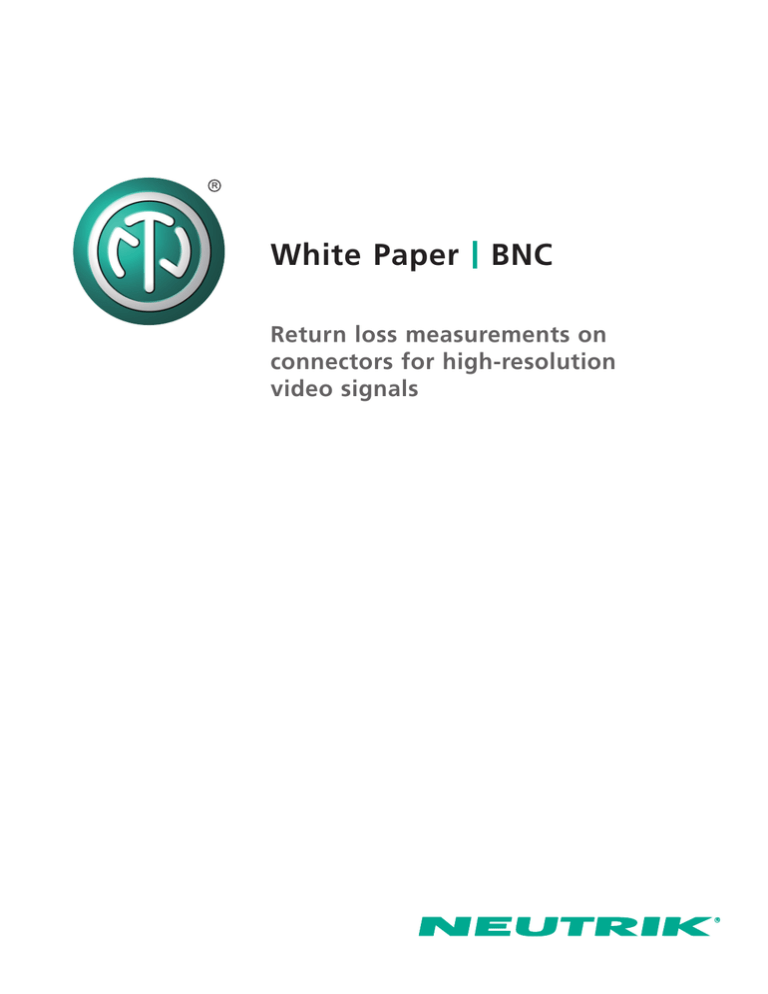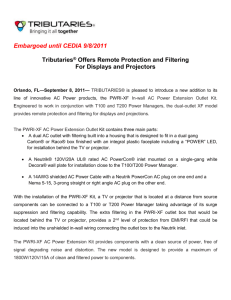
White Paper
I BNC
Return loss measurements on
connectors for high-resolution
video signals
settingstandards
Content
1Abstract ............................................................................................................................................ 3
THEORY.................................................................................................................................................. 3
2 Return Loss ...................................................................................................................................... 3
2.1 What Is Return Loss? ............................................................................................................... 3
2.2 About Return Loss ................................................................................................................... 3
3 How to measure Return Loss up to 18 GHz ................................................................................. 4
3.1Challenges ................................................................................................................................ 4
3.2 Principle - Time Domain Gating (TDG) ................................................................................... 4
MEASUREMENT – TDG METHOD ........................................................................................................ 5
4
Return Loss Measurement up to 18 GHz ......................................................................................
4.1 Measurement Setup & Condition ...........................................................................................
4.2 Measurement Results “non-gated” in frequency and time domain ...................................
4.3 Conclusion & Results................................................................................................................
5
5
5
6
White Paper – BNC
Title: NWP06
© NEUTRIK AG. All rights reserved.
This white paper is a publication of NEUTRIK AG.
This white paper represents the technical status at the time of
printing. The product information, specifications, and all technical data
contained within this white paper are not contractually binding.
NEUTRIK AG reserves the right to make changes at any time to the
technology and / or configuration without announcement.
2
NEUTRIK AG is not to be held liable for statements and declarations
given in this white paper.
NEUTRIK AG explicitly exonerates itself from all liability for mistakes in
this white paper.
settingstandards
1ABSTRACT
Currently, data transport of high definition serial
digital interface (HD-SDI) signals at 3 Gb/s is state
of the art and standardized by the Society of
Motion Picture & Television Engineers (SMPTE).
For return loss and voltage standing wave ratio
(VSWR) measurements, suitable equipment is
available. With upcoming ultra high definition
(UHD) signals and related high frequencies, the
discrepancies between available 50 Ω measuring
equipment and defined 75 Ω video standards
increase.
This paper explains the influence and importance
of return loss in a video system and shows a
suitable test method which Neutrik believes is
the best for high frequencies. Further return loss
measurements compare Neutrik`s new rearTWIST
UHD BNC connector, which is specifically designed
for high frequencies, with UHD optimized
connectors from common manufacturers up to
18 GHz (ST 2082-1).
signals with high bandwidth (e.g. UHD) and
resulting high frequencies, it can be a critical
factor. In addition also the VSWR is a function
of the reflection coefficient, which describes the
power reflected from the end of the system and is
another representation of the return loss.
2.2 About return loss
With the transition to UHD signals, including
4K and 8K signals with their higher data rates
up to 24 Gb/s (ST 2083-1 pending) and related
in-creased clock frequencies, the impedance of
BNC connectors becomes more important than
ever. Every impedance deviation has a negative
influence on the return loss and VSWR values.
In order to maintain the square waveform of digital
signals harmonics (table 1) up to the 5th order
should be considered. Taking the 3rd harmonic
as a limit represents a reasonable compromise
between signal waveform and reliable test results.
DATA RATE
3rd HARMONICS
APPLICATION
3.0 Gb/s
4.5 GHz
HD acc. ST 424
THEORY
6.0 Gb/s
9.0 GHz
4K acc. ST 2081-1
12.0 Gb/s
18.0 GHz
4K acc. ST 2082-1
2
table 1
RETURN LOSS
2.1 What is return loss?
Return loss is signal attenuation caused by
im-pedance variations in the structure of a cable
or associated connection parts like Bayonet Neill–
Concelman (BNC) connectors. These variations
cause some part of the signal to reflect (return)
back to the source. At lower frequencies, return
loss is a minor effect; at frequencies above 50 MHz
it can have a significant impact on the signal
performance and the transmitted distance. For
White Paper – BNC
3
settingstandards
3
HOW TO MEASURE RETURN
LOSS UP TO 18 GHZ
3.1Challenges
As mentioned, for high definition signals (HD) up
to 3 GHz, there are suitable return loss and VSWR
measuring devices available. For 4K and 8K signals
with related high frequencies (table 1), there is
only some dedicated 75 Ω return loss measurement equipment and related calibration kits available, but with limited frequency range (see references No 2.). 50 Ω based test instru-ment systems
have to be used to carry out measurements in the
required extended fre-quency range. The Time
Domain Gating (TDG) method can be used as an
alternative to the conventional S11 (ST2081-1 &
ST2082-1) measurement procedure on frequency
domain in order to avoid calibration uncertainties
due to components (e.g. adapters, matching pad,
etc.) which are not specified for higher frequencies. The major advantage of TDG is an easier visualization and localisation of impedance deviations.
3.2 Principle - Time Domain Gating (TDG)
a) The device under test (DUT) is connected to
the network analyser via a short adapter cable.
This increases the distance between the test
port, any existing adapters and the DUT,
which enhances the distinct identification from
impedance deviations.
b) The measured signal is transformed from frequency to time domain (figure 1 & 2). Similar
to a conventional Time Domain Reflectometer
(TDR), all impedance deviations from DUT
components (e.g. BNC connector, cable, etc.)
can be clearly identified.
4
figure 1
c) A gate (figure 2) with defined start and end
points is positioned on the DUT component
(e.g. BNC connector, cable, etc.) which has to
be measured.
Gate
figure 2
d) Current return loss values inside the gate are
transformed back from the time domain to the
frequency domain (figure 3), representing the
return loss from a defined position within the
DUT.
figure 3
settingstandards
MEASUREMENT – TDG METHOD
4
RETURN LOSS MEASUREMENT
UP TO 18 GHZ
The following return loss measurement demonstrates the functionality of the TDG method by
an ex-ample and compares the performance of
Neutrik`s new rearTWIST UHD BNC with wellknown connectors from US and French manufacturers, offering UHD-optimized BNC connectors,
in order to provide a verifiable reference of commonly used products in the professional broadcast
industry.
4.2 Measurement results “non-gated”
in frequency and time domain
The measured return loss values are transformed
from the frequency domain to the time domain.
The gate (figure 5) is manually positioned (table 3
lists used gate parameters) to measure the BNC
con-nector and blend out the impedance of the
cable, analyser, etc.
PARAMETER
VALUE
Spam
5 ns
Zero point
5,5 ns
End point
8 ns
table 3
4.1 Measurement setup & condition
Figure 4 and table 2 show the measuring setup
including network analyzer, adapter cable, DUT
and a 75 Ω load for the return loss measurement
via TDG method.
Gate
figure 5
figure 4
ITEM
TYPE
Network Analyser
HP 8722D
Adapter cable
SMA terminated with Belden 1694A
(0.8 m length)
and a BNC female jack on the other side
COAX cable DUT
Belden 1694A (8 m)
BNC connectors I
Neutrik rearTWIST UHD BNC
NBNC75BTU11X
BNC connectors II
Common French manufacturer
BNC connectors III
Common US manufacturer
table 2
White Paper – BNC
5
settingstandards
4.3 Conclusion & Results
Figure 6 represents the optimum measuring
setup with minimum connection points to
avoid additional adulteration from the return
loss values. In reality, real broadcast installations
contain multiple BNC connection points which
have significant influence on the return loss
performance. Therefore sufficient distance
(headroom) to the UHD limit is essential to
guarantee appropriate signal transmission.
The goal was to receive verifiable return loss
characteristics of BNC connectors, measured with
a suitable test method for high frequencies up to
18 GHz (ST 2083-1). Due to limited calibration
kits for 75 Ω systems for high frequencies the
TDG method (section 3.2) has been chosen to
measure the return loss of the connector only,
suppressing the impedance deviations of the cable
and adapters.
Neutrik’s new rearTWIST UHD BNC achieves
increased headroom compared to the connectors
from the US or French manufacturers and
offers additional return loss reserve for potential
impedance de-viations resulting from cable
bending, incorrect connector assembly or faulty
connection interfaces without signal interruption.
To compare the new rearTWIST UHD BNC,
specifically UHD optimized connectors from
common manufacturers were used as reference.
All BNC connectors indicate low return loss values
and sufficient headroom to the required UHD
limit (figure 6) over the entire frequency range up
to 18 GHz (ST8083-1). Therefore all 3 connector
types are suitable for high resolution video signal
transmission.
0
UHD-LIMIT
Return Loss [dB]
-10
ST2594
ST292-1
ST424
ST2083-1
ST2082-1
ST2081-1
Headroom
-20
-30
-40
BNC Connector - Manufacturer 1
BNC Connector - Manufacturer 2
Neutrik rearTWIST UHD - BNC Connector
-50
-60
0
5
10
Frequency [GHz]
figure 6
6
15
20
settingstandards
References / Literature
1 Neutrik BNC White Paper “Optimum Performance of Neutrik rearTWIST 75 Ω BNC-Connectors in HD 1080p applications”
2 Samtec “Characterizing Non-Standard Impedance Channels with 50 Ohm Instruments”
3 Belden “High-Definition Cabeling and Retrun Loss”
4 Axon “Adventures In Return Loss”
White Paper – BNC
7
USA
Neutrik USA Inc., 4115 Taggart Creek Road, Charlotte, North Carolina, 28208
T +1 704 972 30 50, info@neutrikusa.com
Japan
Neutrik Limited, Yusen-Higashinihonbashi-Ekimae Bldg., 3-7-19
Higashinihonbashi, Chuo-ku, Tokyo 103
T +81 3 3663 47 33, mail@neutrik.co.jp
Hong Kong
Neutrik Hong Kong LTD., Suite 18, 7th Floor Shatin Galleria
Fotan, Shatin
T +852 2687 6055, neutrik@neutrik.com.hk
China
Ningbo Neutrik Trading Co., Ltd., Shiqi Street, Yinxian Road West
Fengjia Villiage, Yinzhou Area, Ningbo, Zhejiang, 315153
T +86 574 88250488 800, neutrik@neutrik.com.cn
India
Neutrik India Pvt. Ltd., Level 3, Neo Vikram, New Link Road,
Above Audi Show Room, Andheri West, Mumbai, 400058
T +91 982 05 43 424, anklesaria@neutrik.com
Associated companies
Contrik AG
Steinackerstrasse 35, 8902 Urdorf, Switzerland
T +41 44 736 50 10, contrik@contrik.ch
H. Adam GmbH
Felix-Wankel-Straße 1, 85221 Dachau, Germany
T +49 08131 28 08-0, info@adam-gmbh.de
www.neutrik.com
®
France
Neutrik France SARL, Rue du Parchamp 13, 92100 Boulogne-Billancourt
T +33 1 41 31 67 50, info@neutrik.fr
®
Great Britain
Neutrik (UK) Ltd., Westridge Business Park, Cothey Way
Ryde, Isle of Wight PO33 1 QT
T +44 1983 811 441, sales@neutrik.co.uk
BNC White Paper 2015/11 V2 - NWP06 - Data subject to change without prior notice. © 2015 NEUTRIK . NEUTRIK are registered trademarks of NEUTRIK AG. ALL RIGHTS RESERVED.
Germany / Netherlands / Denmark / Austria
Neutrik Vertriebs GmbH, Felix-Wankel-Strasse 1, 85221 Dachau, Germany
T +49 8131 28 08 90, info@neutrik.de
BNC WHITE PAPER
Liechtenstein (Headquarters)
NEUTRIK AG, Im alten Riet 143, 9494 Schaan
T +423 237 24 24, F +423 232 53 93, neutrik@neutrik.com

